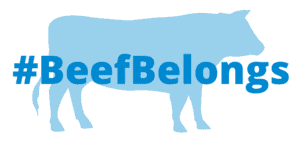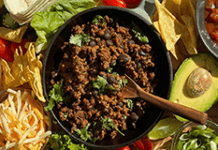PART ONE: Beef and Health – The Untold Story
There’s lots to know about beef. Some things you know, but maybe some things you don’t. With diets getting steadily worse and obesity levels rising, there are some good reasons to consider why beef belongs on the tables of Canadians.
Do Canadians eat too much red meat? In fact, no we don’t.
• Considering there are 21 meals in a week, Canadians eat only 3 servings of fresh red meat per week1 – that’s one lunch and two dinners for example, and this includes pork, lamb or beef. How big is a serving? Only 100 grams – that’s a steak about the size of your palm.
• Think red meat is on the rise as part of Canadian eating patterns? At a 14 gram decrease per day compared to what we ate in 2004, the fact is that there is less red meat than ever in Canadian diets.2
• It’s important to eat a balanced plate that’s ½ fruits and/or veg, ¼ whole grains, and ¼ protein-rich foods like meat. Increase your veggies – for sure, but with only 5% of our calories coming from red meat (and almost 50% from ultra processed foods), worrying about red meat is like trying to fix the wrong problem.1,5
Canadians have replaced foundational foods, like beef, with junk food.
• Over the last 30 years, obesity rates have tripled 3; while the percent of calories we get from high-quality protein foods including beef, milk and eggs has significantly declined.4
• • Ultra-processed food now accounts for almost ½ our daily calories. And alarmingly, our kids are the worst: 9 to 13 year olds get a whopping 57% of their calories from nutritionally poor, high calorie foods such as pizza, pop, crackers and baked goods.5
Is chicken better for you than beef? Maybe not so much…
• Both chicken and beef are nutrient- dense quality protein foods – it shouldn’t be a matter of one or the other. With much to offer in key nutrients like iron, vitamin B12 and zinc, beef belongs at your table. Beef has more of these nutrients than chicken by 200%, 600% and 700% respectively.6
• Beef qualifies as a “good” or “excellent” source of 7 nutrients, while chicken only meets this criteria for 5 nutrients.7
• Lean and Extra Lean Ground Beef have the same maximum fat content as Lean and Extra Lean Ground Chicken or Turkey. The terms that are used to describe maximum fat levels for ground meats apply to all ground meats and poultry and are defined by labelling laws.8
And on the topic of fat…
• On average, fresh red meat contributes only 7% of the fat consumed in the diet of Canadians.9
• More than half of the fat in beef is unsaturated. In fact, most of the unsaturated fat in beef is oleic acid, the same type of healthy fat found in avocados. You know, those “healthy fats” we’re all told to eat.10
• Based on an average composite of beef cuts, beef qualifies for the Health Canada claim ‘lean’.11
Are “plant-based” diets better for you?
Each food in the diet contributes a unique nutrient ‘package’. Plant-based foods offer benefits like fibre and folate, nutrients not present in meat. Meats contribute vitamin B12, Omega-3 fats, complete proteins, heme iron and zinc, nutrients not available from plants. So why the debate? It’s simply not a matter of one or the other.
While it’s true that most people should up their intake of plant-based, healthy foods, plant and animal foods are simply better together.
Eating meat improves nutrient absorption from plant foods. Known as the ‘meat factor’, eating beef or other meats with vegetables that contain zinc and iron improves absorption of those 2 nutrients from the plants by up to 150% for the iron.12
• The fibre in plants helps improve the digestion of meat. These foods belong together.
Vegetarians need almost twice as much iron in their diets as meat eaters since the iron from plant sources is not well absorbed.13
Protein foods are not created equal.
• No other food beats meat when it comes to protein quality. Meats are ‘complete’ proteins with all the indispensable amino acids that humans need and they are easiest for the body to absorb. Plant foods are not complete proteins.
• Nuts, seeds, lentils, chickpeas and beans cannot make the claim ‘rich in protein’. Animal sourced protein foods can – meat is rich in protein.15
• Meat is much more protein dense with more protein per calorie than what plant protein foods have. Consider this: it takes 5.5 servings of almonds at over 900 calories to get the same amount of protein that’s in 1 portion of beef at 245 calories.14
PART TWO: Beef and the Environment – The Untold Story
There’s lots to consider about beef and the impacts it has on the environment. Some things you know, but maybe some things you don’t. Here are some of the little-known facts about raising beef that don’t make the headlines. Good news seldom does. There are key reasons why beef belongs as part of a healthy ecosystem.
Are plant-based diets better for the health of the planet?
• This should be a thoughtful conversation as there is no black and white answer. Whether growing lentils or raising beef, the act of creating any food and getting it to market has environmental impacts.
• It’s complicated. The United Nations cites 14 Sustainable Development Goals. Sustainability assessments usually consider only water use and green house gas (GHG) emission factors. We need to look at the whole picture.1
• A comprehensive literature review study has demonstrated that choosing to consume one food over another is not the solution to reducing food production environmental impacts. Removing cattle from the landscape would have significant negative consequences such as the loss of native grasslands and the fragile Prairie ecosystems.1
• The FAO’s study, Livestock’s Long Shadow has many short-comings and errors authors themselves apologized for. But once the headlines have been made, they are not easy to erase.2
Cattle and greenhouse gases in perspective.
• Transportation in Canada accounts for 28% of Canada’s GHG emissions. Raising cattle in Canada accounts for 2.4% of the GHG emissions in Canada.3,4
• On a global scale, Canadian beef production accounts for only 0.04% of GHG emissions.3,4
Cattle are part of a climate change solution.
• Just as grazing bison kept the grass- lands healthy and viable for centuries, cattle grazing has the same beneficial effects. Unfortunately 74% of Canada’s native grasslands like the Prairies have been lost due to cultivation or development. Eliminating cattle means eliminating vital ecosystems.5
• It’s more than just the grass under your feet. Grass and pasturelands sequester (store) carbon.6 Grass is like the solar panel that captures energy that becomes nourishment (energy) for cattle. Beef is the nutrient-dense good food for us all as a result.
• Cattle provide ecoservice benefits. 68% of the Wildlife Habitat Capacity of all agricultural land in Canada.4 Many bird species at risk and other wildlife call cattle ranges and pastures their home.
An important part of our food-scape.
• Cattle make use of food waste by consuming crops and crop bi-products that can’t be used as human food. For example, in PEI, cattle feed on potatoes that are not suitable for us to eat.
• Cattle can take a food that grows naturally (grass), that we can’t use to eat and turns it into one of natures most nutrient dense foods. Now that’s efficient processing.
• Cattle are typically raised on lands that can’t be used for growing crops and vegetables. You can’t cultivate rocky terrain, areas of brush or dry regions.
• Only 9% of annual cropland is used for growing cattle feed in Canada.4,6
Raising cattle is steeped in tradition NOT stuck in the past.
• Over a 30 year span, feed efficiencies and other technologies have demonstrated a 14% decline in greenhouse gas emissions per kg of beef produced since 1981.7
• Canadian studies track a reduction of 17% in water use to produce a kg of beef over a 30 year period. Water cycles through the environment and does not disappear forever.8
• The Environmental Stewardship Award (TESA) is granted to leaders in stewardship who make outstanding contributions to conservation practices.9
Don’t just take our word for it –
• Conservation groups like the Nature Conservancy of Canada, Ducks Unlimited and Birds Canada work on efforts to help ranchers and farmers keep their cattle grazing.
Four proven dietary changes that we can all make that will make a difference in reducing environmental impacts.
• Reduce waste. One third of our food production results in wasted food.1 Use what you have and don’t let it go to waste.
• Eat less. Over-eating is a type of food waste after all, so consider eating what you need and not more. Keep portions in proportion.
• Buy in season and buy local. Bringing in foods from other countries adds the burden of transportation impacts on the environment.
• Choose food that matters. Make meals with nutrient-dense foundational foods that use less resources to produce and make a valuable contribution to your health and well-being. Processed foods take more energy to manufacture and package.

REFERENCES: PART ONE: BEEF AND HEALTH
1. Canadian Community Health Surveys (Nutrition) 2015, Statistics Canada
2. Canadian Community Health Surveys (Nutrition) 2004 and 2015, Statistics Canada
3. Canadian Health Measures Survey: Household and physical measures data, 2012 to 2013. http://www.statcan.gc.ca/ daily-quotidien/141029/dq141029ceng.htm
4. The growing Canadian energy gap: more the can than the couch? Public Health Nutrition: 12(11), 2216–2224 https://www.ncbi.nlm.nih.gov/pubmed/19531279
5. Moubarac JC. Ultra-processed foods in Canada: consumption, impact on diet quality and policy implications. Montréal: TRANSNUT, University of Montreal; December 2017. http://www.heartandstroke.ca/-/media/pdf-files/canada/media-centre/hs-report-upp-moubarac-dec-5-2017.ashx la=en&hash=9FB9794C42D6B6BA93AB91335E2B6A612656C586
6. Nutrient data derived from Health Canada, Canadian Nutrient File, 2015, food codes: Beef 6172, Chicken, 842.
7. Claim statements based on Daily Values derived from Health Canada, Canadian Nutrient File, 2015, food codes: Beef 6172, Chicken, 842.
8. Canadian Food Inspection Agency. Nutrient Content Claim Requirements for Fat. 2018. http://www.inspection.gc.ca/food/labelling/food-labelling-for-industry/nutrient-content/specific-claim-requirements/eng/1389907770176/1389907817577?chap=4
9. Fresh and Processed Meat Intake: A Canadian Perspective (2018). Data derived from the 2015 Canadian Community Health Survey – Nutrition
10. Health Canada, Canadian Nutrient File, 2015. Food code 6172: Beef, composite cuts, steak/roast, lean and fat, cooked.
11. Health Canada, Canadian Nutrient File, 2015. Food code 6172, beef, composite cuts, steak/roast, lean and fat, cooked.
12. Engelmann, M, Davidsson, L, Sandstrom, B, Walczyk, T, Hurrell, R, & Michaelsen, K. (1998). The influence of meat on nonheme iron absorption in infants. Pediatric Research, 43(6), 768-773.
13. Institute of Medicine. Food and Nutrition Board. HYPERLINK “http://books.nap.edu/openbook.php?record_id=10026&page=R1″Dietary Reference Intakes for Vitamin A, Vitamin K, Arsenic, Boron, Chromium, Copper, Iodine, Iron, Manganese, Molybdenum, Nickel, Silicon, Vanadium, and Zinc : a Report of the Panel on Micronutrients. Washington, DC: National Academy Press; 2001.
14. Health Canada, Canadian Nutrient File, 2015. Food codes: Almonds 2534, Beef 6172.
15. Canadian Food Inspection Agency. Nutrient Content Claim Requirements for Protein. 2018. http://www.inspection.gc.ca/food/labelling/ food-labelling-for-industry/nutrient-content/specific-claim-requirements/eng/1389907770176/1389907817577?chap=3
REFERENCES: PART TWO: BEEF AND THE ENVIRONMENT





